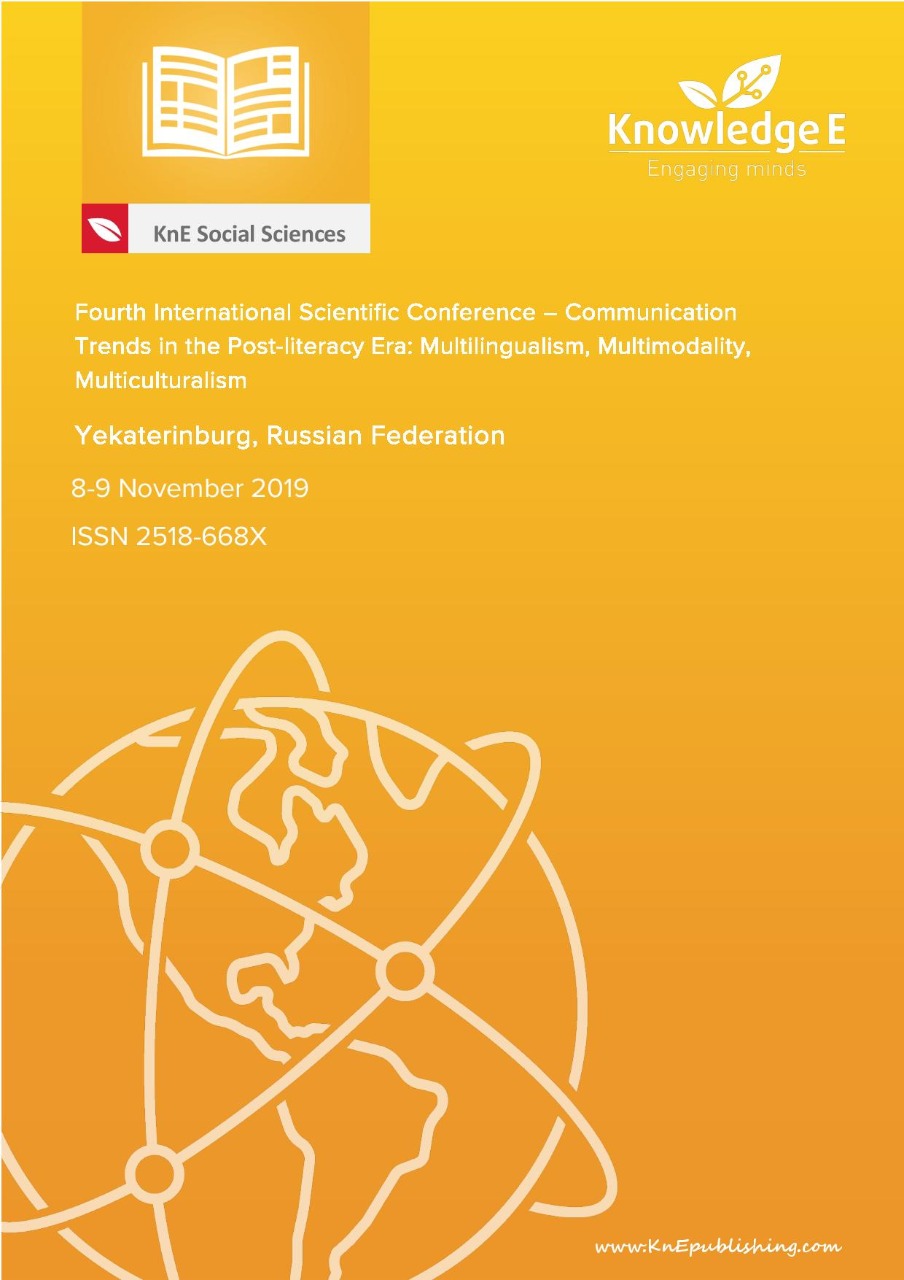Public Opinion Leaders Designing in Modern Neo-Information Society
DOI:
https://doi.org/10.18502/kss.v4i2.6348Abstract
The article discusses the mechanisms of building public opinion leaders in modern neo-information society. A number of methods were applied: a study of the authors using the focus group method ‘Bloggers=influencers?’ (n=10); secondary analysis of the sociological research of the ZIRCON research group in a personal interview “The image of a journalist in the mass consciousness of Russians” (n=1604); a framework analysis of the construction of hype as a social phenomenon in media discourse; authors’ research using the case study method “The phenomenon of Diana Shurygina.” Chronological scope of the study: 2017-2019. It is concluded that the strengthening of the actors of the blogging institution in the media was made possible as a result of a “crisis of confidence” in “traditional” media, in particular television, with a politicized media agenda leading to the acquisition of a propaganda vector, defining thereby the trend of piarisation the media. Being the influencers (mainly for the younger generation, which is exceptionally loyal), bloggers affect the building of a system of norms, values and attitudes of their audience. At the same time, the functioning of bloggers as leaders of public opinion contributes to the inspiration of marketing strategies: the sale of various goods and services through local advertising and product placement, the so-called influential marketing. In addition, by creating social phenomena such as hype, bloggers become drivers of hyponomics (or the economy of hype).
Keywords: leader of public opinion, influencing, media, blogging, hype, hyponomics
References
Yudina, E. N. (2008). The development of the media space of modern Russia (on the example of television). (Unpublished doctoral thesis), Moscow State University, Russia.
Lazarsfeld, P., Berelson, B. and Gaudet, H. (1948). The People’s Choice. How the Voter Makes up his Mind in a Presidential Campaign. New York: Columbia University Press.
Shelonaev, S. I. (2011). Media space: the structure and distribution of social capital of media agents. Society. Environment. Development, no. 4, pp. 81–85.
Volodenkov, S. V. (2016). From the information to communication: communication technologies under the conditions of a modern post-information society. Bulletin of Moscow State Regional University, no. 4, pp. 4–13.
Shelonaev, S. I. (2015). Evolution and prospects of the Russian media space. Modern Mass Media in the Context of Information Technologies, in Proceedings of the First All-Russian Scientific and Practical Conference. St. Petersburg: St. Petersburg State University of Industrial Technology and Design.
Tomin, V. V., Sakharova, N. S., Eremina, N. V., et al. (2016). Intercultural adaptation of students in the information field of cross-cultural interaction. Global Media Journal, vol. S2:7, pp. 1–10.
Bloomer, G. (1984). Society as a Symbolic Interaction. Moscow: Publishing house of Moscow State University. [8] Yefanov, A. A. (2018). The phenomenon of media piarisation. Communicology, no. 6, pp. 34–40.
Safonov, A. V. (2007). ‘Political theater’ as a factor in the formation of social values. Media Environment, no. 2, pp. 130–140.
Yefanov, A. A. (2018). Falling confidence in television: a sociological view of the problem. Bulletin of the South Ural State University. Series: Social Sciences and Humanities, no. 2, pp. 89–94.
Korochensky, A.P. (2015). World journalism: history, theory, practice: a collection of scientific and journalistic works. Belgorod: Publishing House ‘Belgorod.’
Serebryakova, Z. O. (2017). The phenomenon of de-institutionalization of modern Russian journalism as a subject of sociological research. (Unpublished doctoral thesis), Nizhny Novgorod State University.
Means of the mass distrust. The Media Standard Foundation has studied the attitude of Russians to the work of journalists. (2019). Retrieved July 2, 2019, from https://www.rbc.ru/newspaper/2018/10/23/ 5bcc97729a7947e625fc02ba
Tomin, V. V., Bochkareva, T. S., Bogomolova, A. Yu., et al. (2017). Culturological and axiological issues of students’ cross-cultural interaction in the information field. Man in India, vol. 97, no. 25, pp. 263–283.
Russian blogger: what you need to know about working with the opinion leaders. (2019). Retrieved July 4, 2019, from https://www.forbes.ru/karera-i-svoy-biznes/356669-russkiy-bloger-chto-nuzhno-znat-orabote- s-liderami-mneniy
Instagram Influencer Marketing is a 1.7 Billion Dollar Industry. (2019). Retrieved July 4, 2019, from https://mediakix.com/blog/instagram-influencer-marketing-industry-size-how-big/
PR Under the Influence: Why Influencer Marketing is all the Buzz. (2019). Retrieved July 4, 2019, from http://socialprchat.com/pr-under-the-influence-why-influencer-marketing-is-all-the-buzz/
Peers Have Influence Over Consumers, Celebrities Don’t. (2019). Retrieved July 4, 2019, from https: //www.collectivebias.com/blog/blog-2016-03-non-celebrity-influencers-drive-store-purchases
Malchikov, D. K. (2017). Non-standard investment: HYIP, start-up stock exchanges. New Science: Current Status and Development Paths, no. 10, pp. 219–222.
Kolesnik, M.V. (2017). The phenomenon of air selling in the context of modernity. The youth of the third millennium, in Collection of scientific articles, 374-378. Moscow: EXPO.
Rushkoff, D. (2003). Media Virus. How pop culture secretly affects your consciousness. Moscow: Ultra- Culture. [22] Yefanov, A. A. (2018). ‘Hypes’ in the present media field. Sign: The Problem Field of Media Education, no. 1 (27), pp. 63–69.
Kiouru, K.V. (2019). The message in the new media environment as a response to the technological possibilities of modern communications: hype, flogging, sock puppet, in Journalistic Text in a New Technological Environment: Achievements and Challenges. Chelyabinsk: Chelyabinsk State University.
Baudrillard, J. (2006). Consumer Society. Its myths and structure. Moscow: The Cultural Revolution.
Maslow, A. H. (1954). Motivation and personality. New York: Harper and Brothers.
Shurygina became the leader of search queries. (2017). Retrieved March 8, 2017, from https://life.ru/t/%D1%82%D0%B5%D1%85%D0%BD%D0%BE%D0%BB%D0%BE%D0%
B3%D0%B8%D0%B8/982491/diana_shuryghina_stala_lidierom_poiskovykh_zaprosov
Diana Shurygina will appear in the 4th and 5th issue of the Let They Talk program. (2017). Retrieved March 8, 2017, from http://therussiantimes.com/news/184848.html

